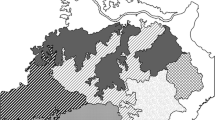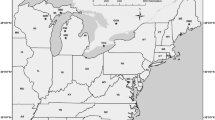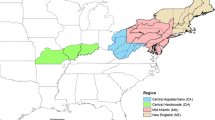Abstract
Lodgepole pine (Pinus contorta Dougl.) is a widely distributed species in the Pacific Northwest of North America. The extent that the current distribution of this species may be altered under a changing climate is an important question for managers of wood supply as well as those interested in conservation of subalpine ecosystems. In this paper, we address the question, how much might the current range of the species shift under a changing climate? We first assessed the extent that suboptimal temperature, frost, drought, and humidity deficits affect photosynthesis and growth of the species across the Pacific Northwest with a process-based model (3-PG). We then entered the same set of climatic variables into a decision-tree model, which creates a suite of rules that differentially rank the variables, to provide a basis for predicting presence or absence of the species under current climatic conditions. The derived decision-tree model successfully predicted weighted presence and absence recorded on 12,660 field survey plots with an accuracy of ~70%. The analysis indicated that sites with significant spring frost, summer temperatures averaging <15°C and soils that fully recharged from snowmelt were most likely to support lodgepole pine. Based on these criteria, we projected climatic conditions through the twenty-first century as they might develop without additional efforts to reduce carbon emissions using the Canadian Climate Centre model (CGCM2). In the 30-year period centered around 2020, the area suitable for lodgepole pine in the Pacific Northwest was projected to be reduced only slightly (8%). Thereafter, however, the projected climatic conditions appear to progressively favor other species, so that by the last 30 years of twenty-first century, lodgepole pine could be nearly absent from much of its current range. We conclude that process-based models, because they are highly sensitive to seasonal variation in solar radiation, are well adapted to identify the importance of different climatic variables on photosynthesis and growth. These same variables, once indentified, and run through a decision-tree model, provide a reasonable approach to predict current and future patterns in a species’ distribution.
Similar content being viewed by others
References
Almeida AC, Landsberg JJ, Sands PJ (2004) Parameterisation of 3-PG model for fast-growing Eucalyptus grandis plantations. Ecol Manag 193:179–195
Austin MP (1985) Continuum concept, ordination methods and niche theory. Ann Rev Ecolog Syst 16:39–61
Barrow EM, Yu G (2005) Climate scenarios for Alberta. A report prepared for the Prairie Adaptation Research Collaborative (PARC) in co-operation with Alberta Environment, University of Regina, Saskatchewan. http://www.parc.ca/research_pub_scenarios.htm
Bechtold WA, Patterson PL (2005) The enhanced forest inventory and analysis program—national sampling design and estimation procedures. General Technical Report SRS-80, US Department of Agriculture, Forest Service, Southern Research Station, Ashville, NC, US
Berry PM, Dawson TP, Harrison PA, Pearson RG (2002) Modelling potential impacts of climate change on the bioclimatic envelop e of species in Britain and Ireland. Glob Ecol Biogeogr 11:453–462
Breiman L, Friedman JH, Olshen RA, Stone CG (1984) Classification and regression trees. Wadsworth International Group, Belmont
Cochran PH, Bersten CM (1973) Tolerance of lodgepole and ponderosa pine to low night temperatures. Science 19:272–280
Coops NC, Waring RH, Landsberg JJ (1998) Assessing forest productivity in Australia and New Zealand using a physiologically-based model driven with averaged monthly weather data and satellite derived estimates of canopy photosynthetic capacity. Ecol Manag 104:113–127
Coops NC, Waring RH, Schroeder T (2009) Combining a generic process-based productivity model and a statistical classification method to predict presence and absence of tree species in the Pacific Northwest, U.S.A. Ecol Model 220:1787–1796
Critchfield WB, Little EL Jr (1966) Geographic distribution of the pines of the world’ US Department of Agriculture Miscellaneous Publication 991, pp 1–97
De’ath G (2002) Multivariate regression trees: a new technique for modeling species–environment relationships. Ecology 83:1105–1117
Dye PJ, Jacobs D, Drew D (2004) Verification of 3-PG growth and water-use prediction in twelve Eucalyptus plantation stands in Zululand, South Africa. Ecol Manag 193:197–218
Eamus D, Jarvis PJ (1989) The direct effects of increases in global atmospheric CO2 concentration on natural and commercial temperate trees and forests. Adv Ecol Res 19:2–56
Easterling DR, Meehl GA, Parmesan C, Changnon SA, Karl TR, Mearns LO (2000) Climate extremes: observations, modeling, and impacts. Science 289:2068–2074
Elith J, Graham CH, Anderson RP (2006) Novel methods improve prediction of species’ distributions from occurrence data. Ecography 29:129–151
Flannigan MD, Logan KA, Amiro BD, Skinner WR, Stocks BJ (2005) Future area burned in Canada. Clim Change 72:1–16
Flato G, Boer GJ, Lee WL, McFarlane NA, Ramsden D, Reader MC, Weaver AJ (2000) The Canadian centre for climate modelling and analysis global coupled model and its climate. Clim Dyn 16:451–467
Green RN, Marshall PL, Klinka K (1989) Estimating site index of Douglas-fir (Pseudotsuga menziesii [Mirb.] Franco) from ecological variables in southwestern British Columbia. Science 35:50–63
Guisan A, Zimmermann NE (2000) Predictive habitat distribution models in ecology. Ecol Model 135:147–186
Hall RJ, Price DT, Raulier F, Arsenault E, Bernier PY, Case BS, Guo X (2006) Integrating remote sensing and climate data with process-based models to map forest productivity within west-central Alberta’s boreal forest: Ecoleap-West. For Chron 82:159–176
Hamann A, Wang T (2005) Models of climatic normals for genecology and climate change studies in British Columbia. Agric Meteorol 128:211–221
Hijmans R, Graham CH (2006) The ability of climate envelope models to predict the effect of climate change on species distributions. Glob Chang Biol 12:2272–2281
Hu J, Moore DJP, Burns SP, Monson RK (2009) Longer growing seasons lead to less carbon sequestration by a subalpine forest. Glob Chang Biol 16:771–783. http://www3.interscience.wiley.com/journal/122377223/abstract?CRETRY=1&SRETRY=0
IPCC (2001) Intergovernmental panel on climate change. Cambridge University Press, Cambridge. http://www.ipcc.ch/pub/online.htm
Iverson LR, Prasad AM (1998) Predicting abundance of 80 tree species following climate change in the eastern United States. Ecol Monogr 68:465–485
Iverson LR, Prasad AM (2001) Potential changes in tree species richness and forest community types follow climate change. Ecosystems 4:186–199
Kimball JS, Running SW, Nemani R (1997) An improved method for estimating surface humidity from daily minimum temperature. Agric Meteorol 85:87–98
Knowles N, Dettinger MD, Cayan DR (2006) Trends in snowfall versus rainfall in the western United States. J Climate 19:4545–4559
Kurz WA, Dymond CC, Stinson G, Rampley GJ, Neilson ET, Carroll AL, Ebata T, Safranyik L (2008) Mountain pine beetle and forest carbon feedback to climate change. Nature 452:987–990
Landsberg JJ, Waring H, Coops NC (2003) Performance of the forest productivity model 3-PG applied to a wide range of forest types. Ecol Manag 172:199–214
Law BE, Goldstein AH, Anthoni PM, Unsworth MH, Panek JA, Bauer MR, Fracheboud JM, Hultman N (2001) Carbon dioxide and water vapor exchange by young and old ponderosa pine ecosystems during a dry summer. Tree Physiol 21:299–308
Little EL Jr (1971) Atlas of United States trees, volume 1, conifers and important hardwoods U.S. Department of Agriculture Miscellaneous Publication 1146, 9 pp
McKenney DW, Pedlar J, Hutchinson M, Lawrence K, Campbell K (2007) Potential impacts of climate change on the distribution of North American trees. Bioscience 57:939–948
McKenzie D, Peterson DW, Peterson DL, Thornton PE (2003) Climatic and biophysical controls on conifer species distributions in mountain forests of Washington State, USA. J Biogeogr 30:1093–1108
Marshall JD, Monserud RA (1996) Homeostatic gas-exchange parameters inferred from 13C/12C in tree rings of conifers. Oecologia 105:13–21
Melendez KV, Jones DL, Feng AS (2006) Classification of communication signals of the little brown bat. J Acoust Soc Am 120:1095–1102
Monserud RA, Yang Y, Huang S, Tchebakova N (2008) Potential change in lodgepole pine site index and distribution under climate change in Alberta. Can J For Res 38:343–352
Mote PW, Hamlet AF, Clark MP, Lettenmaier DP (2005a) Declining mountain snowpack in western North America. Am Meteorol Soc 86:1–39
Mote P, Salathé E, Peacock C (2005b) Scenarios of future climate for the Pacific Northwest. Climate Impacts Group, University of Washington, October 2005. http://cses.washington.edu/db/pdf/kc05scenarios462.pdf. Accessed 3 October 2009
Nightingale JM, Coops NC, Waring RH, Hargrove WW (2007) Comparison of MODIS gross primary production estimates for forests across the U.S.A. with those generated by a simple process model, 3-PG. Remote Sens Environ 109:500–509
Parmesan C, Yohe G (2003) A globally coherent fingerprint of climate change impacts across natural systems. Nature 421:37–42
Pearson RG, Dawson TP, Berry PM, Harrison PA (2002) Species: a spatial evaluation of climate impact on the envelope of species. Ecol Model 154:289–300
Rehfeldt GE, Ying CC, Spittlehouse DL, Hamilton DA Jr (1999) Genetic responses to climate in Pinus contorta: niche breadth, climate change and reforestation. Ecol Monogr 69:375–07
Rodriguez R, Espinosa M, Real P, Inzunza J (2002) Analysis of productivity of radiata pine plantations under different silvicultural regimes using the 3-PG process-based model. Aust For 65:165–172
Root TL, Price JT, Hall KR (2003) Fingerprints’ of global warming on animals and plants. Nature 421:57–60
Sands PJ, Battaglia M, Mummery D (2000) Application of process-based models to forest management: experience with ProMod, a simple plantation productivity model. Tree Physiol 20:383–392
Schwalm CR, Black TA, Amiro BD, Arain MA, Barr AG, Bourque CP, Dunn AL, Flanagan LB, Giasson MA, Lafleur PM, Margolis HA, McCaughey JH, Orchansky AL, Wofsy SC (2006) Photosynthetic light use efficiency of three biomes across and east-west continental-scale transect in Canada. Agric Meteorol 140:260–286
Schroeder TA, Hember R, Coops NC, Liang S (2009) Validation of incoming shortwave solar radiation surfaces for use in forest productivity models. J Appl Meteorol Climatol 48:2331–2458
Schroeder TA, Hamann A, Coops NC, Wang T (2010) Occurrence and dominance of six Pacific Northwest conifer species. J Veg Sci 23(3):586–596
Stape JL, Ryan MG, Binkley D (2004) Testing the utility of the 3-PG model for growth of Eucalyptus grandis xurophylla with natural and manipulated supplies of water and nutrients. Ecol Manag 193:219–234
Swenson JJ, Waring RH, Fan W, Coops NC (2005) Predicting site index with a physiologically based growth model across Oregon, USA. Can J For Res 35:1697–1707
Sykes MT (2001) Modelling the potential distribution and community dynamics of lodgepole pine (Pinus contorta Dougl. ex. Loud.) in Scandinavia. Ecol Manag 141:69–84
Thuiller W, Albert C, Araujo MB, Berry PM, Cabeza M, Guisan A, Hickler A, Midgley GF, Paterson J, Schurr FM, Sykes, Zimmermann NE (2008) Predicting global change impacts on plant species’ distributions: future challenges. Perspect Plant Ecol Evol Syst 9:137–152
Waring RH (2000) A process model analysis of environmental limitations on growth of Sitka spruce plantations in Great Britain. Forestry 73:65–79
Wang G, Huang S, Monserud RA, Klos RJ (2004) Lodgepole pine site index in relation to synoptic measures of climate, soil moisture and soil nutrients. For Chron 80:678–686
Whitehead RJ, Russo GL (2005) Beetle-proofed lodge pole pine stands in interior British Columbia have less damage from mountain pine beetle. Natural Resources Canada. Canadian Forest Service. Victoria BC Information Report BC-X-402
Williams JW, Jackson ST, Kutzbach JE (2007) Projected distributions of novel and disappearing climates by 2100 AD. Proc Natl Acad Sci U S A 104:5738–5742
Author information
Authors and Affiliations
Corresponding author
Rights and permissions
About this article
Cite this article
Coops, N.C., Waring, R.H. A process-based approach to estimate lodgepole pine (Pinus contorta Dougl.) distribution in the Pacific Northwest under climate change. Climatic Change 105, 313–328 (2011). https://doi.org/10.1007/s10584-010-9861-2
Received:
Accepted:
Published:
Issue Date:
DOI: https://doi.org/10.1007/s10584-010-9861-2




